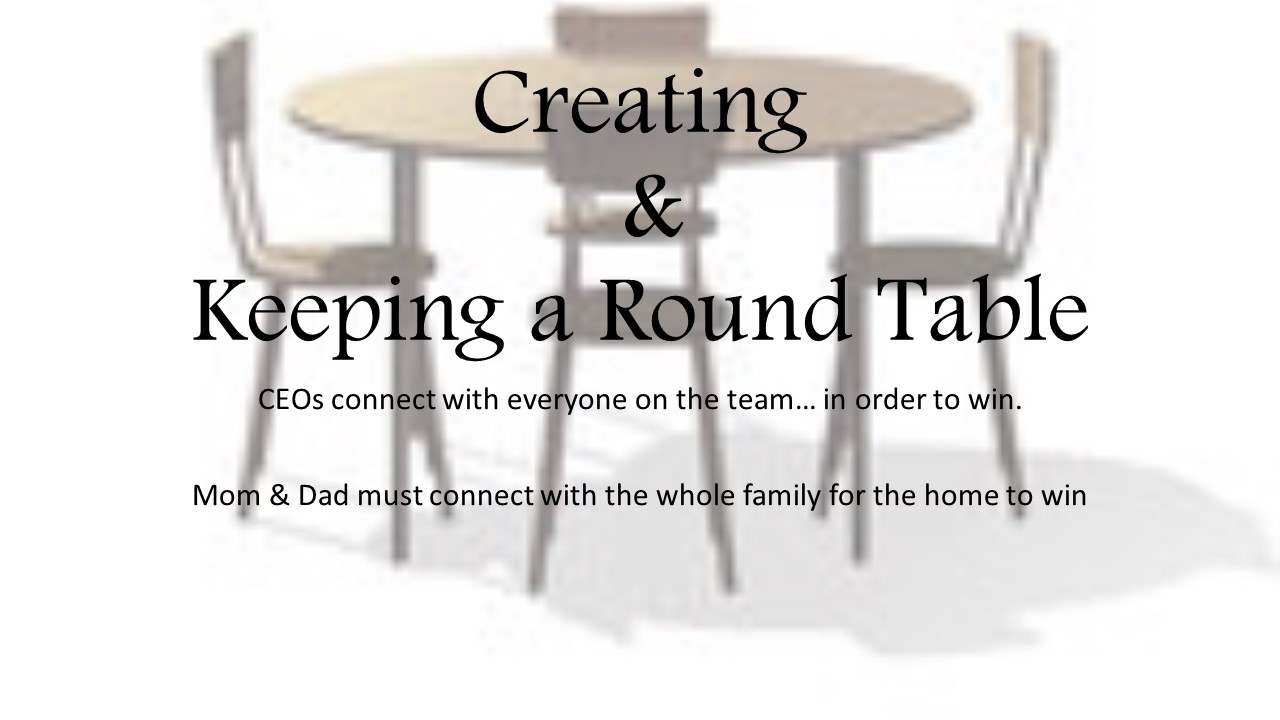
Creating a Round Table
The concept is simple and easy. The application is not. That’s why for many, it’s a totally foreign topic. There are a lot of cultural feelings at play here. It’s not going to happen overnight. Especially if you’ve got children who are a bit older and are not used to the idea.
To make a round table legacy work, one has to get buy-in from everyone. First, both parents have to be in agreement that this is both necessary and beneficial. Without the buy-in, it will be easy to let the idea go the way of New Year’s Resolutions. Worse, the children will easily find flaws and reasons to boycott such meetings. Notably in their teen years.
The CEOs of the home know that sometimes one has to push for change and stick with the program until the results speak for themselves. The wisdom and ability to discern when to stick to a plan and when to pivot is both an art and science that takes time to master.
What Makes a Round Table
A round table is a bit different from just regular family time. It’s the time when the family is business oriented. There is some period of reflection, some period of planning, and some period of looking ahead. Of course, one can sprinkle in a few other periods of time into these meetings to suit the family’s needs. (Growing up, ours had a praise and thanksgiving emphasis…part of where I learned gratitude)
With that in mind, start off with easy topics. There is an agenda, there is a goal, there is a time limit, and there is a commitment to follow up.
Before we start with the easy topics, one more point. Most round tables will have greater success if they’re built around the vision of the family. The vision for the future. If that is not in place, the first few meetings can be about finding out the vision of the family. Not just the vision of the parents. (Of course, little children won’t contribute as much to the discussion as older ones can) keep in mind… vision does change over time… albeit not dramatically
In future posts, we’ll break down the various ways to get going, keep going, and things to address (ideas only) in the family round table meetings.
For some, it’s once a month. Others it is once a quarter. It all depends on the topics, the ages of the children, and the needs of the family. Those without children can jump straight in full throttle with the administrative functions of the home and relationship… as two adults can do that.
note. This is not limited to just the nuclear family. It does look a bit different when involving the extended family
Look at this like you would a mastermind group. This is the board meeting of the family. This is the educational platform of the family. This is the steering committee of the family. This is the focus group of the family.
Ground Rules
The Round Table is safe territory. No retaliations. No ideas is dumb. No “harshing” on anyone. No criticism or belittlement of anyone. This is a safe place.
It has to be a safe place or else… one person or group of individuals will railroad the meeting at the expense of the other.
Plus, if the place is safe, there are bits of information that will surface in these meetings that will not otherwise surface during the day to day living. That can be from the children, or the parents, or anyone who is allowed to be in and who respects the sanctity of confidentiality.
Everyone gets equal voice and equal access to the discussion. Of course, there are topics that have to be age appropriate. For discussions that can only have some of the members and not all, it is wise to have the group agree and discuss the agreement first before having a separate session. That way everyone is on-board with that smaller discussion.
this does not mean the parents can’t have their own meetings and discussions that the children do not know about
Encourage everyone to do their homework before coming to the meeting to increase the productivity of the meeting. That is not limited to researching a topic, getting advice on a topic before hand, and having notes ready before hand. It’s a business meeting. Children will learn to be ready for real life meetings by seeing how it’s done at home.
The family is allowed to set their ground rules. Each family has it’s ways of doing things. This blog will not give a comprehensive set of rules.
The ego has no room at the table. Many parents will veto ideas from children that challenge their way of thinking. Please, check the ego at the door. There is no room for egos in the family CEO round table meetings. By nurturing the children’s ability to think critically and give input, you’re teaching the how to become leaders in their own home.
There are stories of adults who learned from their children by listening to how they think. That ability to learn has allowed them to improve their own careers. Remember, many adults have to work with young teammates. My boss is younger than me and I’m not considered old by any stretch of the imagination. Imagine the advantage a Baby Boomer has when his Millennial children help him understand the changing work landscape… all because pride was checked at the door.
Keeping a Round Table
One meeting does not make a successful new habit. When the meeting is over, a new time has to be agreed on… if it’s not a preset amount of meetings. Then, everyone is responsible to keep the others accountable for attending the next meeting. The parents have to be committed to keeping their schedule clear for the next meeting.
yes, some flexibility has to be accounted for in real life
